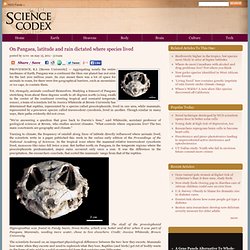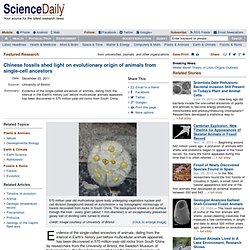

The Genius Of Charles Darwin - Part 3 - God Strikes Back. The Genius Of Charles Darwin - Part 2 - The Fifth Ape. The Genius Of Charles Darwin - Part 1 - Life, Darwin & Everything. Evolution Discussion Questions. Evolution: Extinction. The Story of Mankind. How did life originate? How did life originate?

Living things (even ancient organisms like bacteria) are enormously complex. However, all this complexity did not leap fully-formed from the primordial soup. Instead life almost certainly originated in a series of small steps, each building upon the complexity that evolved previously: Simple organic molecules were formed. Simple organic molecules, similar to the nucleotide shown below, are the building blocks of life and must have been involved in its origin. Multicellularity evolved. Top 10 Myths About Evolution – with Downloadable PDF. Email If you have been looking for a simple, easy to follow quick guide to evolution… we’ve got it.

Our friends at the Skeptics Society gave us permission to reprint this. Below is the text. Learn it. Share it. Original Text: 1 If Humans Came From Apes, Why Aren’t Apes Evolving Into Humans? Humans, apes, and monkeys are only distant evolutionary “cousins.” New Hypothesis for Human Evolution and Human Nature. Click on image for a high-resolution version. Domestic animals, like this water buffalo in Viet Nam, live intimately with humans and provide renewable resources to humans that communicate well with them. Photo by Greg Luna. 20 July 2010 — It's no secret to any dog-lover or cat-lover that humans have a special connection with animals. But in a new journal article and forthcoming book, paleoanthropologist Pat Shipman of Penn State University argues that this human-animal connection goes well beyond simple affection. Shipman proposes that the interdependency of ancestral humans with other animal species — "the animal connection" — played a crucial and beneficial role in human evolution over the last 2.6 million years.
"Establishing an intimate connection to other animals is unique and universal to our species," said Shipman, a professor of biological anthropology. On Pangaea, latitude and rain dictated where species lived. PROVIDENCE, R.I.

[Brown University] — Aggregating nearly the entire landmass of Earth, Pangaea was a continent the likes our planet has not seen for the last 200 million years. Its size meant there was a lot of space for animals to roam, for there were few geographical barriers, such as mountains or ice caps, to contain them. Yet, strangely, animals confined themselves. Chinese fossils shed light on evolutionary origin of animals from single-cell ancestors. Evidence of the single-celled ancestors of animals, dating from the interval in Earth's history just before multicellular animals appeared, has been discovered in 570 million-year-old rocks from South China by researchers from the University of Bristol, the Swedish Museum of Natural History, the Paul Scherrer Institut and the Chinese Academy of Geological Sciences.

All life evolved from a single-celled universal common ancestor, and at various times in Earth history, single-celled organisms threw their lot in with each other to become larger and multicellular, resulting, for instance, in the riotous diversity of animals. However, fossil evidence of these major evolutionary transitions is extremely rare. The researchers studied the microscopic fossils using high energy X-rays at the Swiss Light Source in Switzerland, revealing the organisation of the cells within their protective cyst walls. Do Humans Matter? New research may show that Neandertals did not go extinct. By Philip Guelpa 27 December 2011 The recently reported results of genetic research comparing samples of fossil Neanderthal DNA with that of modern populations around the world appear to indicate that modern humans outside of Africa derive some portion of their genetic material from Neanderthals. This finding, if supported by further research, has important implications, not only in answering the longstanding question of what happened to the Neanderthals, but more importantly for our understanding of the relative weight of cultural versus biological adaptation in human evolution.
Written in Bone - A Highly Unusual Case. In 2002, archaeologists uncovered an isolated grave just outside the log wall of a fort built on an island in the James River almost four centuries earlier.

Who was buried there? Male skeleton (burial partially re-created for an exhibition) 1607, James Fort site, Jamestown Virginia. Image courtesy of: APVA Preservation Virginia/Historic Jamestowne The discovery mystified investigators. Unlike nearly all the other early fort burials they had found, this one once held a coffin. Smithsonian forensic anthropologists joined archaeologists from APVA Preservation Virginia who were excavating the site where the fort once stood—the first permanent English settlement in North America. The Smithsonian Institution's Human Origins Program. Darwin Pond. Ancestry5_large.jpg (3000×1536) 50 Reasons I reject Evolution. 1.)

Because I don’t like the idea that we came from apes… despite that humans are categorically defined and classified as apes. 2.) Because I’m too stupid and/or lazy to open a fucking book or turn on the Discovery Science Channel. 3.) Because if I can’t immediately understand how something works, then it must be bullshit. 4.) 5.) 6.)